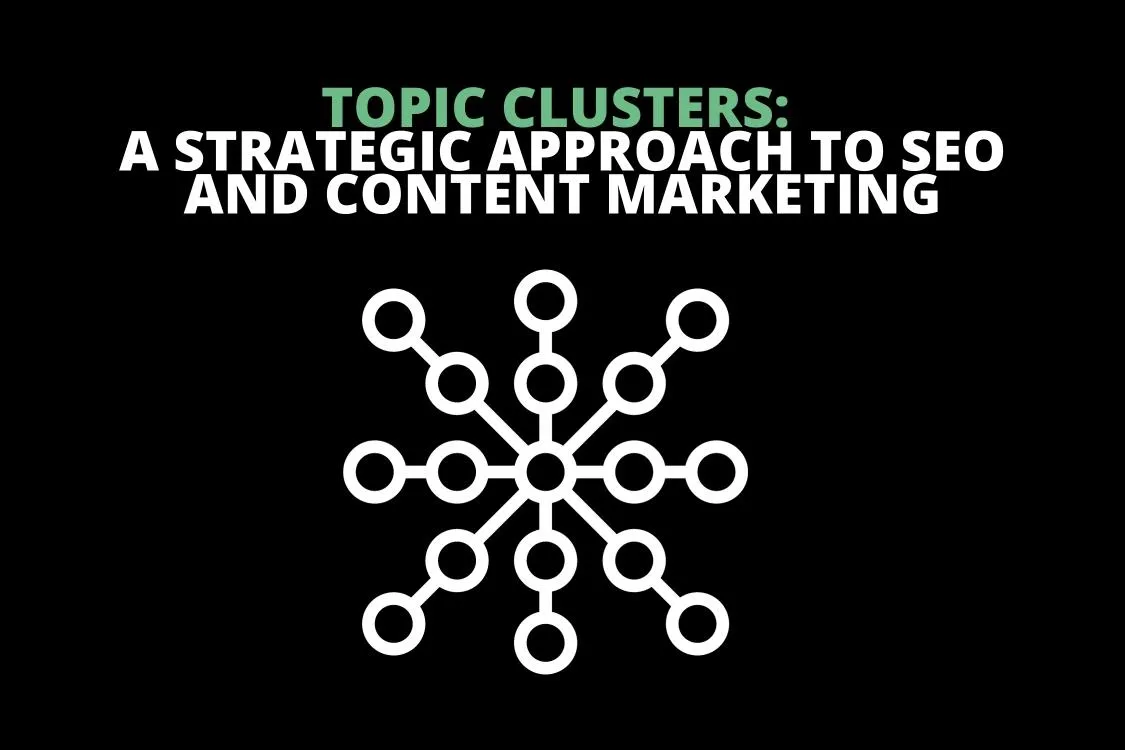Blog

Topic Clusters: A Strategic Approach to SEO and Content Marketing
In the ever-evolving landscape of SEO, topic clusters (or content clusters) have emerged as a powerhouse content strategy, revolutionizing the way digital marketers build their site architecture and approach keyword optimization. But what exactly are topic clusters? Imagine them as constellations in the vast universe of your website content, where each cluster forms a coherent group of interlinked articles orbiting around a central pillar topic. This approach not only enhances user experience but also signals to search engines the depth and breadth of your site's knowledge on core subjects.
Benefits of Using an SEO Topic Cluster Strategy
By adopting a topic cluster strategy, you're essentially building a web of content that's both user-centric and SEO-friendly. Think of it as creating a mini Wikipedia for every subject relevant to your brand. This method boosts SEO rankings by ensuring that when one page performs well, the entire network benefits through increased keyword rankings and the establishment of topical authority.
Moreover, a well-organized site structure through topic clusters leads to improved user engagement. Users find themselves navigating effortlessly through a logical flow of information, which in turn can lead to higher search engine rankings.
How Topic Clusters Help Google Understand Your Site
Google's algorithms are like meticulous librarians that prefer well-categorized information. Topic clusters help these algorithms understand your website's hierarchy and the relationship between various pieces of content. By establishing a clear topical authority, you're essentially telling Google, "Hey, we're experts in this field," which can significantly boost your SEO and search engine rankings.
Getting Started with Topic Clusters
Embarking on the journey of creating topic clusters begins with a solid foundation. Here's how you can lay the groundwork for a strategy that will elevate your content marketing game.
The Role of a Content Audit in Enhancing Cluster Content
Before diving headfirst into creating new topic clusters, it's crucial to understand the current state of your content. This is where a content audit becomes invaluable. A content audit is like conducting a thorough inventory check of your website's type of content, which helps you identify what's working, what's not, and most importantly, uncover hidden opportunities for your topic clusters.
Uncovering Gaps and Opportunities
A content audit allows you to take stock of all the content you've published. By evaluating each piece, you can identify gaps in your content that may represent opportunities for new cluster content. For instance, if you're a fitness brand and notice you have multiple articles about diet but few about workout routines, there's a clear opportunity to build a new cluster around exercise-related content.
Assessing Content Performance
Understanding which pieces of content are performing well can guide your topic cluster strategy. A content audit involves analyzing metrics such as page views, bounce rates, and conversion rates. Content that has high engagement and conversion rates is a strong candidate for becoming pillar content within a topic cluster.
Ensuring Content Quality and Relevance
A content audit isn't just about quantity; it's also about quality. It helps ensure that the content you include in your topic clusters is accurate, up-to-date, and relevant to your audience's needs. During the audit, you might find outdated articles that need refreshing or low-quality pages that could be consolidated into more comprehensive guides.
Identifying Strong Keywords and Themes
During the audit, you'll also be able to spot which keywords and themes are already bringing organic traffic to your site. These insights can inform your topic cluster strategy by highlighting which topics you should continue to build upon and which new related topics could be introduced to capture additional search traffic.
Streamlining Site Structure
A content audit can reveal how well your current site structure is organized and whether it's optimized for both users and search engines. By mapping out how your pillar content and supporting posts are interlinked, you can plan a more cohesive topic cluster structure that improves navigability and strengthens your site's internal linking.
Aligning with Business Goals
Finally, a content audit aligns your content strategy with your business goals. It ensures that every piece of content serves a purpose, whether it's to inform, engage, convert, or retain your audience. By aligning your topic clusters with your business objectives, you can create content that not only ranks well but also drives business results.
Choose a Central Topic
Selecting a central topic is like choosing a flagship product for your brand. It should be something that resonates with your audience and represents your expertise. For instance, if you're a digital marketing agency, your central topic could be 'Digital Marketing Trends.' This topic is broad enough to branch out into various subtopics yet focused enough to maintain coherence.
Identify Your Core Topics and Sub-Topics
After establishing your central broad topic, it's time to identify the supporting content pillars - your core topics and sub-topics. These should be areas where you've seen past success or where there's a clear audience interest. For example, under 'Digital Marketing Trends,' sub-topics might include 'Voice Search Optimization' or 'AI in Marketing.'
Research Search Queries and Volume
Understanding the search queries and volume associated with your topics is crucial. Tools like SEMrush or Ahrefs can help you gauge the traffic potential and economic value of your chosen keywords. For instance, 'Voice Search Optimization' might have a high search volume but also a high CPC, indicating both competition and conversion potential.
Create Content for Your Pillar Topics and Sub-Topics
Now, it's time to create content. For each core pillar topic and sub-topic, you'll want to produce high-quality, informative content that directly addresses user search intent. Let's say one of your sub-topics is 'How to Optimize for Voice Search.' This piece should cover everything from the basics of voice search to advanced optimization techniques, incorporating long-tail keywords throughout.
Mastering Internal Linking: Connecting Subtopics to Pillar Content
Internal linking is a critical component of the topic cluster model. It's not just about linking pages together; it's about creating a strategic web of connections that boosts the user experience and search engine optimization (SEO). Let's delve into how internal linking should be handled between subtopics and pillar content.
The Art of Linking Subtopics
When you create content for a topic cluster, each subtopic should not only stand alone as a valuable resource but also serve as a part of a larger narrative. This is where internal linking plays a pivotal role.
Contextual Linking: Each subtopic page should include links to other relevant subtopics within the same cluster. This approach helps in providing additional context and depth to the reader. For example, in a topic cluster about "Digital Marketing," a subtopic page on "Social Media Marketing" might link to related subtopics like "Email Marketing" or "Content Marketing."
User Journey Consideration: The links should be placed thoughtfully, considering the user's journey. If a subtopic addresses a more advanced aspect of the main topic, link back to more fundamental subtopics for readers who might need foundational knowledge.
Keywords and Anchor Text: Use descriptive and keyword-rich anchor text for these links. This not only helps with SEO but also guides the user on what to expect when they click the link.
Linking Subtopics to Pillar Content
The pillar content acts as the cornerstone of your topic cluster. It's a comprehensive resource that covers the main topic broadly, while the subtopics delve into specific aspects. Here’s how to effectively link subtopics to your pillar content:
Highlighting the Pillar Page: Each subtopic page should include a link to the pillar page. This can be done through direct mentions in the content or using a consistent call-to-action (CTA) format.
Reinforcing Topical Authority: By linking subtopics back to the pillar page, you're signaling to search engines that your pillar content is the authoritative source for the broader topic. This can enhance the pillar page’s authority and ranking potential.
Ease of Navigation: From a user experience perspective, these links make it easy for readers to access a more comprehensive view of the topic, enhancing their understanding and engagement with your content.
Best Practices for Internal Linking
Balance and Relevance: Avoid over-linking. Each link should add value and relevance to the content.
Link Placement: Place links where they feel natural in the content flow. Forced or awkward linking can detract from the user experience.
Link Maintenance: Regularly check your internal links to ensure they are not broken and still lead to relevant and updated content.
Optimizing Your Topic Clusters for SEO
The final step is to ensure your topic clusters are fully optimized for SEO. This includes creating long-tail keywords that fit naturally within your content, writing compelling titles and meta descriptions, and utilizing internal links effectively.
Creating Long-Tail Keywords That Fit Your Topic Clusters
Long-tail keywords are your secret weapon. They're less competitive and more targeted. Using tools like Answer the Public, you can uncover long-tail gems that will attract a more focused audience. For example, 'best practices for voice search SEO in 2023' is a long-tail keyword that could drive highly targeted organic traffic to your site.
Writing Compelling Titles & Meta Descriptions
Your titles and meta descriptions are like the cover of a book – they need to draw readers in. A title like 'The Ultimate Guide to Voice Search SEO' paired with a meta description that promises comprehensive insights into optimizing for voice search will entice clicks and drive traffic.
Utilizing Internal Links in Your Content
Internal links not only help users navigate your site but also help search engines understand the structure and hierarchy of your content. They distribute ranking power and context throughout your cluster, reinforcing the strength of your topic content cluster strategy.
Leveraging SERP Features: Targeting Featured Snippets and Related Questions
Featured snippets and related questions (often seen in the "People also ask" section) on search engine results pages (SERPs) are prime real estate in SEO. Capturing these spots can significantly increase visibility and drive traffic. Here’s how to format your content to target these features effectively.
Understanding Featured Snippets
Featured snippets are selected search results that are featured on top of Google's organic results below the ads in a box. They aim to answer the user's question right away. Being featured here means your content is seen as highly relevant and authoritative.
Types of Featured Snippets
Paragraph Snippets: These are a block of text that answers a query directly. Ideal for who, what, why, and how questions.
List Snippets: These appear for content that lists items or steps, like recipes or how-to guides.
Table Snippets: Data organized in a table format, often used for schedules, pricing, or specifications.
Targeting Featured Snippets
Identify Common Questions: Use tools like AnswerThePublic or Google’s “People also ask” to find common questions in your niche.
Directly Answer Questions: Start sections with a clear, concise question, followed by a direct answer. This format is snippet-friendly.
Optimize for Paragraph Snippets: Keep answers to 40-50 words for paragraph snippets. Answer directly and succinctly.
List and Table Formats: For list or table snippets, format your content in a numbered or bulleted list, or a clear table. This helps Google easily pull this data for a snippet.
Formatting Content for "People Also Ask" (PAA)
The "People Also Ask" box is a dynamic feature showing questions related to the original search query. Here’s how to optimize for it:
Incorporate PAA Questions: Include common PAA questions in your content and provide clear, concise answers.
Subheadings for Questions: Use the exact questions as subheadings (H2 or H3) to increase the chances of Google recognizing and pulling this content.
Structured Content: Structure your content logically around these questions, ensuring each section is self-contained and directly answers the question.
Best Practices for Featured Snippets and PAA
High-Quality Content: Ensure your content is authoritative, well-researched, and provides value.
Use of Schema Markup: Implement schema markup to help search engines understand the context and content of your page.
Regular Updates: Keep your content updated as featured snippets often pull from the most current and relevant sources.
Monitoring & Improving Search Rankings for Your Core Topics & Sub-Topics
Keep a close eye on how your content performs. Use SEO tools to track keyword rankings and analyze content performance. This data will guide your ongoing strategy and help you make necessary adjustments to stay ahead of the curve.
Developing an Effective Content Marketing Strategy with Topic Clusters
Topic clusters are not just an SEO tactic; they're a comprehensive content marketing strategy. By choosing a central topic, identifying core topics and sub-topics, conducting keyword research, creating content, internal linking it all together, and optimizing for SEO, you're building a fortress of content that's impenetrable by competitors.
In conclusion, topic clusters are a strategic and methodical approach to SEO and content marketing that can lead to significant improvements in search engine rankings, user engagement, and overall site authority. By following the steps outlined above and using hypothetical examples as a guide, you can create a robust topic cluster strategy that will serve as the backbone of your content marketing efforts. Need help? Check out our NJ SEO solutions.


